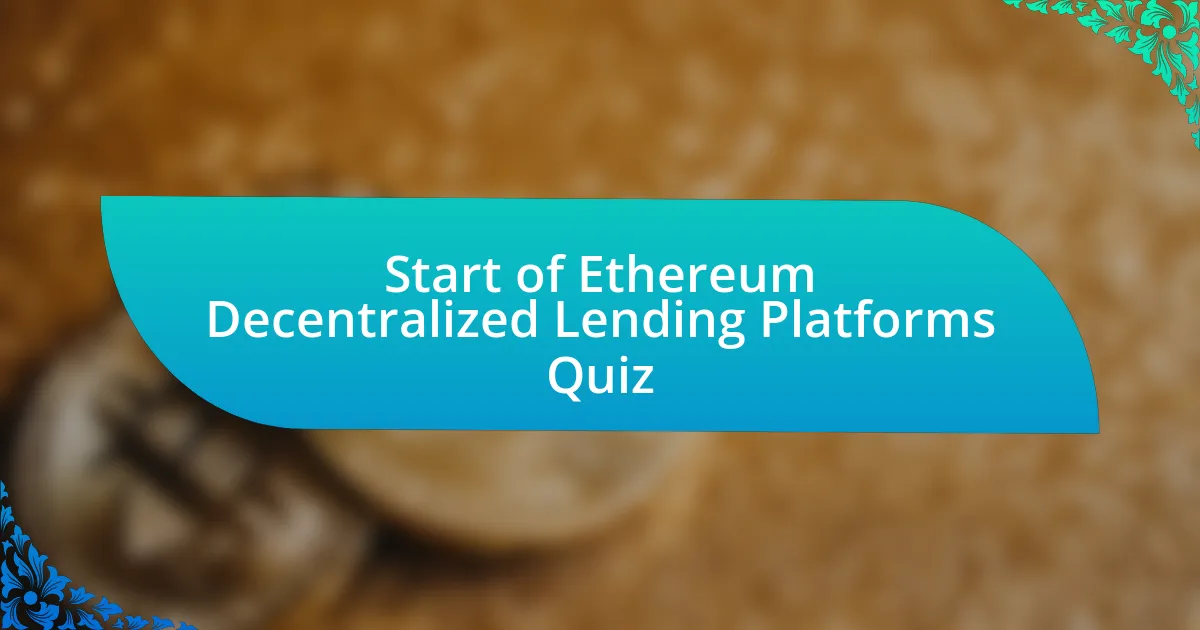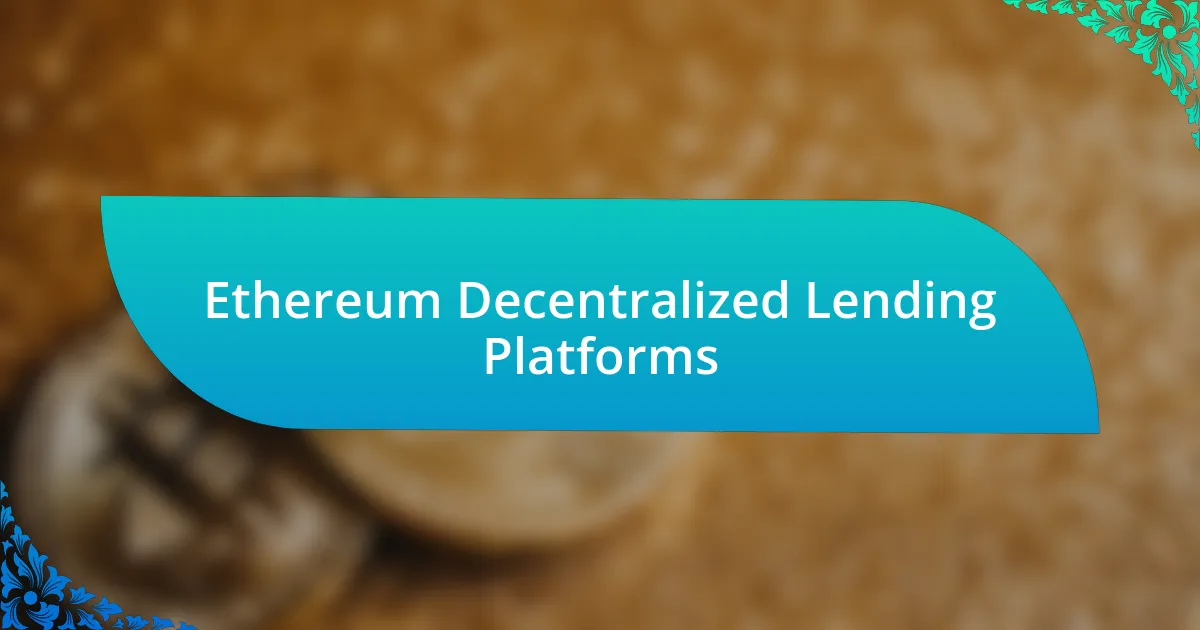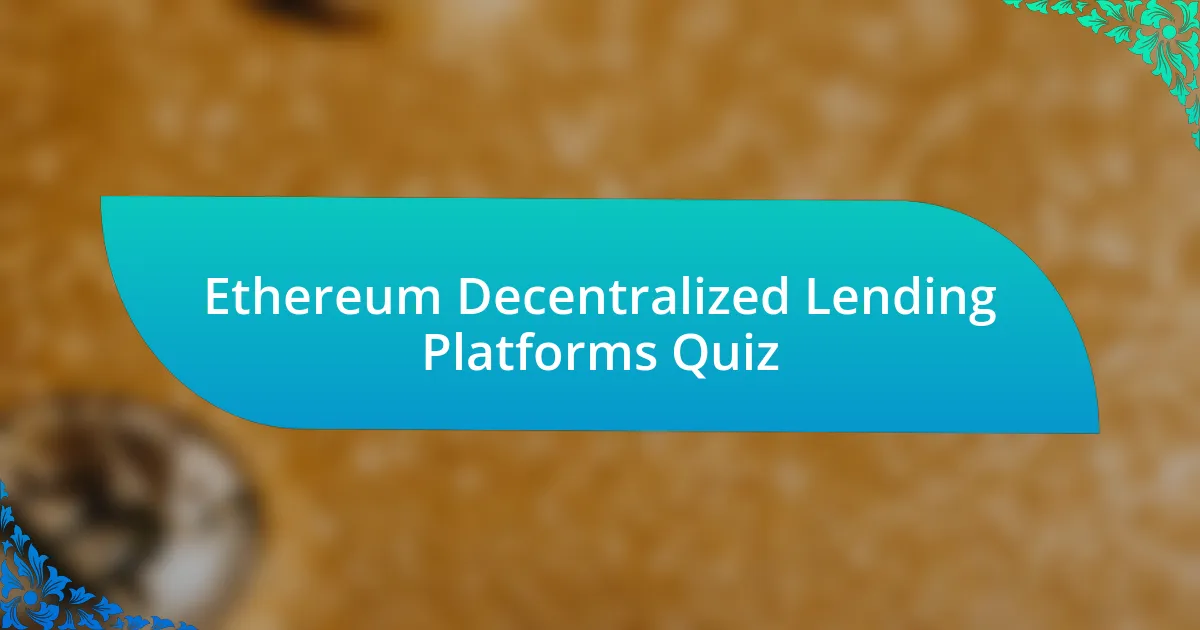
Start of Ethereum Decentralized Lending Platforms Quiz
1. What is the main function of Ethereum-based decentralized lending platforms?
- Create non-fungible tokens for artists
- Allow users to play games using cryptocurrency
- Enable users to lend and borrow crypto assets
- Facilitate the exchange of fiat currency for crypto
2. How do users earn interest on their assets in decentralized lending platforms?
- By using their assets to purchase physical goods.
- By trading stocks and bonds in secondary markets.
- By providing collateral and lending assets on the platform.
- By holding cryptocurrencies in a traditional bank account.
3. What role does smart contract technology play in decentralized lending?
- Smart contracts only store user data without execution commands.
- Smart contracts are used solely for trading cryptocurrencies.
- Smart contracts automate and enforce loan agreements in decentralized lending.
- Smart contracts manage centralized financial institutions.
4. Which token is primarily used for transactions on Ethereum`s lending platforms?
- Aave
- Ripple
- Bitcoin
- Litecoin
5. How does the Aave platform provide liquidity to its users?
- Aave provides loans without collateral.
- Users lend assets to the Aave liquidity pool.
- Aave allows users to directly trade tokens.
- Aave charges a fee for every transaction.
6. What distinguishes Compound from traditional lending systems?
- It requires credit scores for loans.
- It enables algorithmic markets.
- It relies on centralized banks.
- It uses paper contracts only.
7. In what year was Ethereum launched, marking the start of decentralized finance innovations?
- 2015
- 2016
- 2013
- 2017
8. What unique feature did Alchemix introduce to the decentralized lending space?
- Borrowing against yield from collateral
- Lending without collateral requirements
- Instant loan approval process
- Fixed interest rates for all borrowers
9. How do flash loans function within the Aave lending platform?
- Flash loans can be borrowed for any duration and do not require repayment in a single transaction.
- Flash loans allow users to borrow assets without collateral, provided they return it within the same transaction.
- Flash loans automatically convert borrowed assets into a stablecoin for user convenience.
- Flash loans require users to provide a significant amount of collateral before borrowing.
10. What is the purpose of collateral in decentralized lending on Ethereum?
- To increase interest rates
- To secure a loan repayment
- To decrease loan limits
- To eliminate transaction fees
11. Which decentralized lending platform allows for risk management features?
- Bitfinex
- Aave
- Ripple
- Binance
12. What is the significance of interest-bearing tokens in decentralized finance?
- They are used to enhance the security of blockchain networks.
- They help in increasing transaction speeds on the Ethereum network.
- They allow users to borrow against their assets while earning interest.
- They facilitate direct trading between users without intermediaries.
13. How can decentralized lending platforms impact the traditional banking system?
- Decentralized lending platforms eliminate all forms of banking completely.
- Decentralized lending platforms can reduce the need for traditional banks as intermediaries.
- Decentralized lending platforms will cause traditional banks to thrive even more.
- Decentralized lending platforms only serve large investors and ignore individuals.
14. What is the primary goal of the TrueFi protocol?
- TrueFi is a service for issuing stablecoins.
- TrueFi is a system for managing decentralized exchanges.
- TrueFi is a platform for asset swapping.
- TrueFi is a protocol for uncollateralized lending.
15. What mechanism does the Cream Finance protocol use to facilitate quick loan acquisition?
- Margin trading
- Flash loans
- Yield farming
- Staking rewards
16. What benefits do users gain from borrowing against their crypto assets?
- Users can access liquidity without selling their crypto assets.
- Users receive exclusive trading discounts on exchanges.
- Users increase their crypto assets through taxation benefits.
- Users gain higher rewards for holding their crypto long-term.
17. How does the LiquidStaking feature in BENQI enhance user experience?
- LiquidStaking only benefits institutional investors, not individuals.
- LiquidStaking requires users to lock their assets for a long period.
- LiquidStaking allows users to earn rewards while holding their staked assets.
- LiquidStaking eliminates the need for any transaction fees.
18. What is the difference between undercollateralized and over-collateralized loans?
- Over-collateralized loans are unsecured and do not need collateral.
- Undercollateralized loans require less collateral than the loan amount.
- Undercollateralized loans require full collateral to secure the loan.
- Over-collateralized loans are always riskier and require no collateral.
19. What innovations does the Euler protocol provide to the lending space?
- The Euler protocol allows users to earn interest on their crypto assets.
- The Euler protocol only supports centralized lending practices.
- The Euler protocol is exclusively for institutional investors.
- The Euler protocol requires users to sell their crypto assets for loans.
20. Which platform utilizes reputation scores to provide loans without collateral?
- Sublime
- Aave
- Alchemix
- Compound
21. How does Notional`s fixed-term lending model differ from others?
- Notional offers fixed-rate loans for a specified term.
- Notional allows only variable-rate lending options.
- Notional is limited to short-term loans only.
- Notional requires collateral in stablecoins for lending.
22. What is the significance of the Gearbox Protocol in lending practices?
- Gearbox Protocol is a cryptocurrency mining platform focused on high yield returns.
- Gearbox Protocol is a network for storing digital assets securely off the blockchain.
- Gearbox Protocol is a two-sided lending marketplace connecting passive investors and leveraged users.
- Gearbox Protocol is a lending service that requires users to provide full collateral for loans.
23. How does the Liquity protocol ensure interest-free loans for users?
- Liquity provides loans that require monthly interest payments based on collateral value.
- Liquity charges a small fee to cover interest payments on loans.
- Liquity offers variable interest rates that fluctuate according to market conditions.
- Liquity allows users to borrow against Ether without interest through a unique collateral system.
24. What are the implications of using automated systems for liquidity provision?
- Greater reliance on manual oversight and intervention
- Increased transaction fees and longer processing times
- Limited accessibility for small investors or users
- Enhanced market efficiency and reduced risk
25. How do decentralized lending platforms enhance financial inclusivity?
- Decentralized lending platforms only cater to wealthy investors.
- Decentralized lending platforms provide access to financial services for unbanked individuals.
- Decentralized lending platforms limit user accessibility to loans.
- Decentralized lending platforms increase reliance on traditional banks.
26. What security measures are implemented in platforms like Alchemix to protect user assets?
- Open access protocols
- Centralized storage
- Single user control
- Multi-signature wallets
27. How does Maple Finance cater specifically to institutional clients?
- Maple Finance operates exclusively with retail investors.
- Maple Finance provides tailored lending solutions for institutional clients.
- Maple Finance focuses on social media marketing for bonds.
- Maple Finance only invests in cryptocurrencies for individuals.
28. What challenges do decentralized lending platforms face in compliance and regulation?
- Developing a centralized governance model for decision-making
- Ensuring all users have adequate credit histories
- Implementing traditional banking practices and structures
- Navigating evolving regulatory frameworks and compliance requirements
29. What is the economic model that underpins the Compound protocol?
- Traditional barter system
- Algorithmic money market
- Fixed rate lending
- Centralized banking system
30. In what ways do lending platforms like Aave and Compound compete with traditional financial institutions?
- They provide decentralized lending without intermediaries.
- They require credit scores for borrowing.
- They only operate in fiat currencies.
- They charge high fees for transactions.

Congratulations, You’ve Completed the Quiz!
Thank you for engaging with our quiz on Ethereum Decentralized Lending Platforms. We hope you found the process enjoyable and informative. This quiz has been designed to enhance your understanding of decentralized finance and how Ethereum is revolutionizing lending. From concepts like liquidity pools to smart contracts, it’s fascinating to see how these innovations are shaping the financial landscape.
Throughout this quiz, you may have learned about the key players in the decentralized lending space, such as Aave and Compound. Understanding how they leverage blockchain technology can empower you as you explore investment opportunities. You’ve also gained insights into the risks and benefits associated with these platforms, which is essential for making informed financial decisions.
To further expand your knowledge, we invite you to navigate to the next section on this page. Here, you will find in-depth information about Ethereum Decentralized Lending Platforms. Whether you are a novice or an experienced user, there’s always more to learn. Dive deeper into the world of decentralized finance and enhance your expertise!

Ethereum Decentralized Lending Platforms
Understanding Ethereum Decentralized Lending Platforms
Ethereum decentralized lending platforms are financial protocols built on the Ethereum blockchain. They allow users to borrow and lend cryptocurrencies without the need for intermediaries. This decentralized nature empowers users with full control over their assets. Smart contracts facilitate transactions, ensuring transparency and security. Popular platforms like Aave, Compound, and MakerDAO exemplify this model, utilizing Ethereum’s capabilities to offer innovative financial services. The rise of these platforms reflects a growing trend towards financial autonomy and disintermediation in the crypto landscape.
Key Features of Ethereum Decentralized Lending Platforms
Key features of Ethereum decentralized lending platforms include collateralization, interest rate mechanisms, and liquidity pools. Users must typically over-collateralize their loans, providing greater collateral than the amount borrowed. Interest rates are often dynamic, adjusting based on supply and demand within the platform. Liquidity pools allow users to contribute funds, which can then be lent out to borrowers, generating interest. These features collectively enhance user participation and stability within the lending ecosystem.
How Borrowing Works on Ethereum Decentralized Lending Platforms
Borrowing on Ethereum decentralized lending platforms generally involves deposit collateral and receiving a loan in cryptocurrency. Users select an asset to provide as collateral, which is locked in a smart contract. The platform then determines how much can be borrowed based on the collateral’s value. Upon repayment, the collateral is released. If the collateral value drops too low, the system can automatically liquidate the assets to cover the loan. This mechanism ensures platform solvency and protects lenders’ interests.
Popular Ethereum Decentralized Lending Platforms
Popular Ethereum decentralized lending platforms include Aave, Compound, and MakerDAO. Aave offers features like flash loans and diverse asset support, catering to various user needs. Compound allows users to earn interest on their deposits while borrowing against their collateral. MakerDAO focuses on stablecoin issuance through collateralized debt positions (CDPs), allowing users to generate Dai, a stablecoin pegged to the US dollar. These platforms showcase the diverse applications of decentralized finance on Ethereum.
The Future of Ethereum Decentralized Lending Platforms
The future of Ethereum decentralized lending platforms appears promising, with ongoing innovation and growth. As the DeFi ecosystem expands, more users are engaging with these platforms. Increased institutional interest and advancements in scaling solutions could lead to further adoption. Additionally, regulatory developments may influence the sustainability and legitimacy of these platforms. Ultimately, Ethereum’s decentralization ethos is likely to shape future lending dynamics in the broader financial landscape.
What are Ethereum Decentralized Lending Platforms?
Ethereum Decentralized Lending Platforms are blockchain-based financial services that enable users to lend and borrow cryptocurrencies without intermediaries. These platforms use smart contracts to facilitate lending transactions and determine terms such as interest rates and collateral requirements. A prominent example is Compound, which allows users to earn interest on deposited assets while borrowing against them, tracking assets via Ethereum’s blockchain technology.
How do Ethereum Decentralized Lending Platforms work?
Ethereum Decentralized Lending Platforms function by allowing users to provide liquidity in the form of cryptocurrencies that others can borrow. Users deposit their assets into a smart contract, which governs the lending process. Borrowers must provide collateral and are charged interest determined by supply and demand. The smart contract automates the transaction, ensuring transparency and security in its operations. For instance, Aave allows users to choose between stable or variable interest rates for their loans.
Where can you find Ethereum Decentralized Lending Platforms?
You can find Ethereum Decentralized Lending Platforms primarily online through websites and applications associated with decentralized finance (DeFi). Popular platforms include Compound, Aave, and MakerDAO, each accessible via web browsers or their respective applications. These platforms are built on the Ethereum blockchain and can be interacted with using compatible cryptocurrency wallets like MetaMask and WalletConnect.
When did Ethereum Decentralized Lending Platforms emerge?
Ethereum Decentralized Lending Platforms began to emerge around 2018, coinciding with the rise of decentralized finance (DeFi). The launch of platforms like Compound in 2017 marked a significant development in lending within the cryptocurrency space. Since then, the DeFi ecosystem has expanded rapidly, with many new platforms and protocols appearing annually, particularly in 2020 during the DeFi boom.
Who uses Ethereum Decentralized Lending Platforms?
Users of Ethereum Decentralized Lending Platforms typically include cryptocurrency holders seeking to earn passive income, borrowers needing liquidity, and investors looking to leverage their assets. These platforms attract individual investors, traders, and often institutions that wish to participate in the DeFi space without traditional banking intermediaries. Data shows that billions of dollars are locked in these platforms, indicating their popularity among various crypto enthusiasts and developers.

